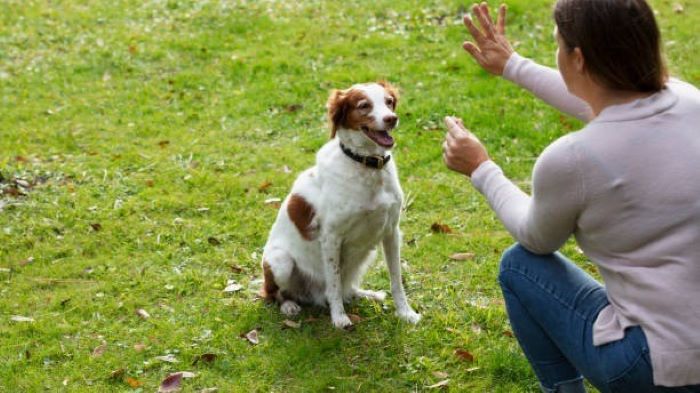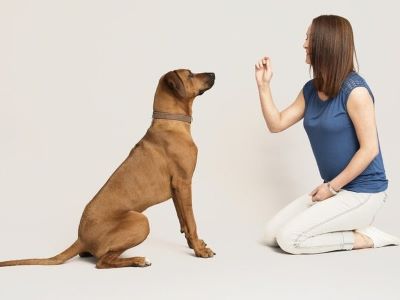Have you been having trouble training your pup, or maybe they’ve lost touch with the commands? They say teaching an old dog new tricks is hard, but that’s not always true. A whistle could do the trick. But, “How To Use A Dog Whistle?” Let’s find out.

How To Use A Dog Whistle?
Sir Francis Galton is the inventor of Dog Whistles. Galton originally designed it to test the capabilities and range of human hearing. He quickly understood that dogs can hear high-pitched sounds[1] of up to 45,000Hz. While the frequency range for us humans is 18,000Hz.
The first dog whistle was silent (a more fitting name is ultrasonic whistle). It is silent to human ears but dogs can hear the high-pitched sound. This is handy as only your pet can hear the sound, not other people around.
The second kind of whistle has a pea (ball) inside it. When you blow the whistle, the ball clacks, creating sound. If you’re from a cold environment, there is a possibility of the pea freezing. It is better to invest in a pea-less whistle.

There are many advantages to using whistles such as:
- It is much better to whistle than to scream and yell. And the whistle travels further as a matter of fact.
- A whistle will always give you a similar tone. With humans, our tones change with our moods, we will yell when angry. This is not good for pets and will make them forget their commands.
“Also, whistles have the added advantage of not showing emotions like frustration and desperation,” says Stanley Coren from Psychology Today. “Dog whistles are consistent in the sounds that they emit.”
- The dog whistle is only for dogs. Other humans do not get disturbed.
- Once the commands are set, for example, two blows for sit or shake. There is no mistaking it on the dog’s part. Commands will be crystal clear to your pet.
The Complete Guide to Whistle Training Your Pet
Now that you’re aware of the benefits of using whistles for training, let’s get started. Always be patient with yourself and your pet, you are both learning something new. It is bound to take time.
- Finding the Perfect Whistle: Dogs do not react similarly to all frequencies. Some breeds might be sensitive to certain frequencies. A trick some pet parents adopt is to blow different kinds of whistles until the pet responds.
- Introduce the Whistle: Here, you as trainer, will blow the whistle and give treats to your pets. Stop all interaction with your pup, no playing, no feeding, no commands. You have to bore them and then when they’re least expecting it, blow the whistle. Award your puppy when they react.
- Associate Whistle With Reward: Never use the whistle to punish your pet. Always award your pet for reacting to the whistle. If you use the whistle to call your pet, only to punish them, they will form a negative association with the whistle.
- Teach Basic Commands: Start with basic commands for sit, stand, and come (recall). Do not start outside, in a dog park or crowded area. Set yourself up for success with small steps to achieve. For example, when your dog is at the other end of the hall, you can blow the whistle and reward them for coming to you.
- Practice in Different Environments: After your pet has learned the basic commands, it’s time to practice in different, outdoor environments. You can start with your backyard. Once they respond well there, you can try reinforcing the command in crowded places like the dog park.
Using The Whistle To Teach Basic Commands
When learning to use a dog whistle, you must become familiar with the usual commands that can be used.
For example, a short, sharp blow can instruct your pet to sit. You can use two consecutive blows in a row to ask your pet to stay. A series of short blows on the whistle can suggest your dog come to you. Two long consecutive blows can indicate to your pet to quit barking.

Remember to be consistent with the whistle and to only use it for positive reinforcement. Never ask your pet to come to you, only to punish them. This can form a negative association with the whistle.
FAQs
How to use a dog whistle?
The first step is to find the perfect whistle that your dog reacts to, then we can begin to train. In the beginning, reward your pet whenever it reacts to the whistle. Then gradually introduce commands and reinforce them with treats. Then you can practice these commands outdoors, starting with a backyard and then a garden.
When should you use a dog whistle?
Dog whistle is used in recall training. It can be used to quiet down barking and basic tricks like sit, heal, lie down, and stand. It is important to use a dog whistle only for positive actions/habits. If you use the whistle to call your dog, only to yell at them, the dog will form a negative association with the whistle.
Do all dogs respond to dog whistles?
Some dogs are more sensitive and some are less. It is thus, crucial to get a dog whistle that your dog responds to positively, usually with a head tilt or ears standing. If the dog is sensitive to the frequency, they might start barking and dogs less sensitive may not react at all.
Do dog whistles attract dogs?
It will certainly get other pooches’ attention if they hear the whistle for the first few times. But, eventually, they will be desensitized to the sound and won’t react. If the whistle isn’t pitched perfectly it can irritate dogs and cause them to bark and react loudly.
What are the disadvantages of a dog whistle?
Since most dog whistles are silent and only audible to dogs. It is hard to hear what we want to communicate. If the dog whistle is used often and not for teaching a command, it can lose its value. Your pet may become used to the sound and won’t react. They can also form a negative association with the whistle if not used appropriately.
Conclusion
Now, that you know “How To Use A Dog Whistle?” you can form a new and better bond with your pup. Thanks to the whistle you now can teach an old dog new tricks.
Keep your training sessions with your pet fun and mentally stimulating. We hope you have a fun time with your pet.
References:
- Dogs Don’t Have a Sixth Sense, They Just Have Incredible Hearing. American Kennel Club.



